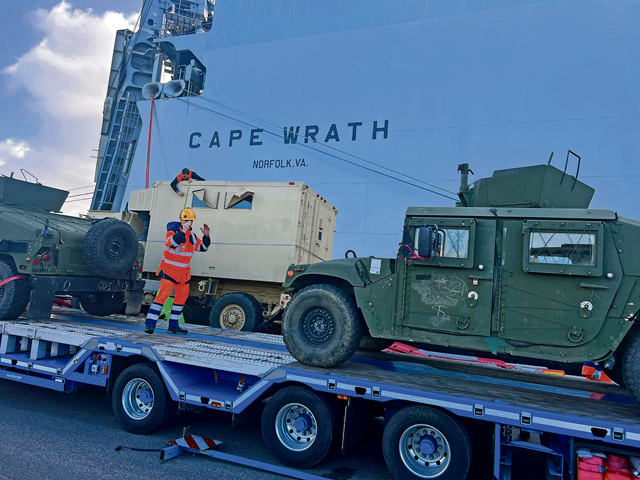
The MV Cape Wrath made a bold statement when it pulled into the port of Livorno Oct. 28, carrying equipment assigned to the 3rd Brigade Combat Team, 101st Airborne Division (Air Assault). Soldiers and civilians from the 386th Movement Control Team, 16th Sustainment Brigade, 21st Theater Sustainment Command and 839th Transportation Battalion, 598th Transportation Brigade, made sure that message was delivered.
“I told them in the rehearsal of concept, when they see the Cape Wrath pulling into the port of Livorno, it is all about being able to project combat power in any region of the world, in the time and place of our choosing,” said Lt. Col. Michael Harrell, 839th Transportation Battalion commander.
The reception and staging of more than 450 pieces of equipment, including Humvees, palletized loading systems and light trucks was the largest U.S. port operation in Livorno in more than five years. Equally important are the onward movement plans for transporting the organic equipment belonging to the 3rd IBCT/101st ABN DIV (AASLT), from Fort Campbell, Kentucky. The unit is also known as the Rakkasans.
“For the first time, after so many years, we will be able to load a train with 48 pieces that will go to various destinations in eastern and northern Europe,” said Monica Simoncini, 839th Trans BN terminals and documentation chief.
According to 2nd Lt. Samuel Rupert, 386th MCT, remaining equipment will be transported via commercial line haul. He said teamwork and planning are critical when transporting the equipment from Italy through various European nations.
“It’s a lot of interfacing with line haul companies, rail companies, working with the unit movement officers and 839th to make sure all of the correct equipment is downloaded and moved forward to wherever it needs to go across eastern Europe,” said Rupert.
He added that a benefit to receiving equipment through Livorno is being able to take advantage of the longstanding relationships the U.S. has forged in Italy, including the knowledge and expertise of its local national workforce.
“The U.S. has been here [in Italy] since 1952, so we have those long, tied-in relationships,” said Rupert. “Italy has been a long-term partner to the United States. It’s good to be able to use that partnership. We have Camp Darby right down the road, and it’s a great asset to be able to store equipment and stage it and move some of the harder cargo across Europe.”
He said he was excited about doing the mission from the port of Livorno, as it opens the whole southern side of the European theater to a new entrance.
“It’s awesome to be able to open up a new port, especially when we are so tied in and we have the ability to take our time and do it right,” said Rupert.
Helping to make sure everything was done right, Sgt. 1st Class Ana Schroeder, 3rd IBCT/101st ABN DIV (AASLT) mobility noncommissioned officer in charge, was in Livorno overseeing the safe operation and deployment of her unit’s equipment and people.
“It is important that our equipment maintains its state of readiness whenever it gets to our forward location so that we are prepared to move when necessary and to jump into the fight at all times,” said Schroeder. She appreciated the teamwork that went into their deployment.
“Our experience with the 21st TSC movement control team has been seamless and effortless,” said Schroeder. “They are a huge asset and have been readily available and knowledgeable to answer any questions we have and to assist with whatever we might need.”
Schroeder said her unit is excited to work with U.S. allies in Europe.
“We are ready to show Europe why we are known around the world,” she said. “Europe will get to see the Rakkasans in action.”
The Rakkasans are deploying approximately 3,400 soldiers in a one-for-one unit replacement, as the 1st Infantry Brigade Combat Team, 101st Airborne Division, redeploys back to Fort Campbell, Kentucky. The deployment is in support of European and NATO allies and partners, and does not change the overall U.S. force posture in the region.


